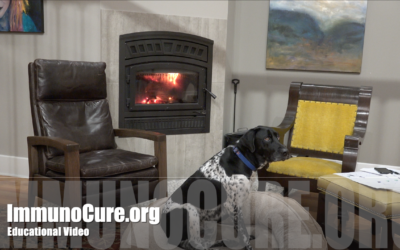March 2020
The entire world is on a quarantine lockdown, and the global economy is being destroyed. Something needs to happen to change the course of this viral attack and our response. I am an immunologist and as the founder and lead scientist with the ImmunoCure Foundation I feel it is my duty to humanity to try and help. We our just establishing our foundation and we do not have the infrastructure in place for me to conduct cellular research at this time. I have been trying to figure out a way to help, and this is my solution. Although I cannot find scientific data on the immune profiles of the current patients I am relying on previous scientific evidence I can acquire.
I have been reading everything I can about the current Corona virus (Covid-19), SARS (Sever Acute Respiratory Syndrome), and MERS-CoV (Middle East Respiratory Syndrome Coronavirus). Not only are they similar in structure, and transmission, but they also all cause severe respiratory illness, which is causing the global shutdown. This severe respiratory response only occurs in a very small percentage (~4% of + tests, but testing is limited) and yet the spread of the virus is so widespread this small percentage is holding the rest of the world hostage. The respiratory illness is so deadly the patients with this response require ventilators to breathe. The world healthcare system is ill-equipped to handle a widespread respiratory illness of this magnitude. Therefore, most people who are not ill, and many who will never show serious symptoms are quarantined to help save lives destined to be lost due to the inadequacies of a healthcare system hijacked by big Pharma, and other selfish money grabbing entities. In my opinion healthcare, incarcerations, and military should never be allowed to make anyone a profit.
OK, enough of the soapbox rants let’s get back to work!
The severe respiratory response occurs in such a small percentage of people I believe it must be an excessive immune response. Most of us love peanut butter, but a small percentage of people will die upon consuming it. My hypothesis is, if we can eliminate the respiratory threat to this small percentage we should be able to get back to our lives. Not everyone survives the annual flu. Elderly and immune-compromised individuals are more at risk, but with Covid-19 I believe the real danger is to the small percentage of individuals who will experience an excessive immune response. I have been going through scientific publications trying to figure out a way to help with this situation from my locked down quarantined couch. Without actually having access to current patient’s immune profiles (cytokine, chemokine, T cells, neutrophils etc.) I am just guessing. But my guess is an educated one, and at least I am doing SOMETHING TO HELP!
We need to find a way to ameliorate the immune response causing the respiratory illness and therefore lessen the need for respirators. After reading several scientific publications I am currently investigating the possibility of the immune suppressant drug Rapamycin (Sirolimus). Rapamycin is commonly used to suppress the immune response in organ transplant patients. I have decided to begin adding reviews of my readings and hopefully this will become helpful. We need to find a medication to shutdown the excessive respiratory response. If we can eliminate the need for ventilators we can all get back to our lives, and the severe response patients can breath again.
Rapamycin-I
Rapamycin Attenuates Acute Lung Injury induced by LPS through inhibition of Th17 cell proliferation in mice.
Scientific Reports | 6:20156 | DOI: 10.1038/srep20156 https://www.ncbi.nlm.nih.gov/pmc/articles/PMC4757870/
Is Rapamycin a viable treatment for severe lung inflammation with COVID-19?
This paper can be located at the above link. Acute Lung Injury (ALI) is currently defined as Acute Respiratory Distress Syndrome (ARDS) and is caused by neutrophil induced inflammation. Note: remember SARS stands for Severe Acute Respiratory Syndrome. In this paper they measured the concentration of cytokines in the plasma of patients suffering from sepsis- related ARDS finding consistently high levels of the IL-17 and IL-22, both T helper -17 cell cytokines. They collected plasma concentrations of both IL-17 and IL-22 from ARDS patients on days 1, 3, and 7 of their illness. The patients who did not survive their lung infections demonstrated a continued increase in both IL-17 and IL-22 compared to the patients who survived.
Collecting plasma/ blood / tissue samples from COVID-19 patients is essential to finding out what is causing their excessive respiratory response. At this time I am unable to locate any of this current data. All I can do is review previous case studies and experiments to try to find correlations. This publication states:
“Uncontrolled inflammation may be a risk factor for poor prognosis in patients with ARDS. Managing the proliferation and differentiation of Th17 cells is thought to be an effective treatment.”
These researchers also conducted a mouse study using LPS to induce the lung inflammation. Lipopolysaccharides (LPS) are found on pathogens and used to fuse with the lipid membrane of the host cell. LPSs are commonly used to induce an excessive immune response to be studied. Their mouse model for ALI also demonstrated an increase in the Th-17 cytokines. Mice genetically lacking interleukin 17 (IL-17–/– Mice) did not accumulate activated neutrophils and lung inflammation was decreased when compared to the WT (wild type) control mice. Lung inflammation and neutrophil count was increased in WT mice dosed with recombinant cytokines IL-17 and IL-22. They found Rapamycin to attenuate the lung damage by blocking the proliferation of T helper 17 cells. When mice were treated with Rapamycin the lung fluid concentrations of cells, neutrophils, IL-17, IL-22, and TNF-a were all decreased.
In short, lung inflammation decreased with Rapamycin. I must emphasize again, I do not have access to the current plasma profiles of the COVID-19 patient with severe acute respiratory distress. I do not know if they have an increase in IL-17 and IL-22 cytokines. I am just learning what I can in case this can somehow be helpful in the future. I have run Rapamycin studies previously so I am somewhat familiar with the inhibition pathway, and its longterm use by pediatric liver transplant patients.
Rapamycin-II
T cells and Lung Injury. Impact of Rapamycin
Am J Respir Cell Mol Biol. 2014 Aug; 51(2): 294–299.
https://www.ncbi.nlm.nih.gov/pmc/articles/PMC4148036/
“Clinical Relevance
Rapamycin is a specific inhibitor of mTOR, a kinase required for cellular proliferation. These studies examined the effects of rapamycin on inflammation in a LPS-induced murine model of acute lung injury (ALI). Rapamycin administration before or after onset of ALI, as well as systemically or by pulmonary routes, ameliorates inflammation in ALI. These findings have the potential to affect future therapeutics for ALI.”
This is the second paper investigating the effects of administering Rapamycin to decrease Acute Lung Injury. They claim evidence of alveolar edema upon infiltration by neutrophils and macrophages in the alveoli. Neutrophils are known to disrupt the alveolar-capillary barrier. Rapamycin inhibits T cell activation and targets mTOR, this study focused on T cell – associated molecules CTLA4 and FoxP3. In this study the researchers also used LPS to induce ALI (acute lung injury) in mice. However, they were more interested in the cytokines IL-6 and IL-10 along with the Akt-mTOR pathway, a known target of Rapamycin. Please forgive the immunology references, believe me I am trying to limit them. I just want to reach a wide audience, and I want healthcare workers with knowledge of these cytokines etc. to be able to gather at least some pertinent information from this. Again I have included the link so you can look at the data they collected with this work.
Rapamycin reduces LPS induced pulmonary inflammation in vivo.
Previously these researchers determined that T cells following the CTLA4 pathway increase the ALI response. And this paper demonstrates the administration of Rapamycin decrease CTLA4 and T cell activation.
Previous paper referenced:
“T cell pathways involving CTLA4 contribute to a model of acute lung injury.
Nakajima T, Suarez CJ, Lin KW, Jen KY, Schnitzer JE, Makani SS, Parker N, Perkins DL, Finn PW
J Immunol. 2010 May 15; 184(10):5835-41.”
I wont go into more detail on this paper, in short they also found Rapamycin to decrease lung inflammation whether administered prior to or after onset of the acute respiratory distress.
Rapamycin-III
Rapamycin ameliorates lipopolysaccharide-induced acute lung injury by inhibiting IL-1b and IL-18 production
International Immunopharmacology
Volume 67, Fevruary 2019, Pages 211-219
https://www.sciencedirect.com/science/article/pii/S1567576918313055
This is my third Rapamycin publication review. I do not have full access to this publication so this is just from the abstract. In this paper they stained for and therefore collected data on cytokines IL-1b and IL-18. Their findings indicate a decrease in leukocyte infiltration in both the lung tissue and the bronchoalveolar lavage fluid (BALF) with Rapamycin. And the acute lung injury inflammation was alleviated. Their highlights state:
- The mTOR inhibitor Rapamycin can ameliorate acute lung injury
- Leukocytes IL-1b and IL-18 are inhibited by Rapamycin
- Autophagy and NF-kB activation increase while IL-1b and IL-18 decrease
- Rapamycin reduces leukocyte infiltration in lungs
Comments
Allow me to be clear here. I do not know if Rapamycin will help ameliorate the lung inflammation in severe COVID-19 patients. I do know we have the capabilities to determine the immune profile of these patients within a few hours. If the cytokines I have mentioned above are elevated in these patients then Rapamycin or another immunosuppressant may help them to breathe again. With the fatality rate as it is I do not understand why we are not exploring this option. I truly hope we are not just waiting for a vaccine. A vaccine the entire world will need to have if we want to continue breathing. Rapamycin has been on the market long enough it has a generic version, Sirolimus and of course the only people requiring this treatment are the small % experiencing the deadly lung inflammation.
I want to now write a few reviews on scientific publications demonstrating we already know Severe Acute Respiratory Syndrome is caused by an excessive immune response.
Coronavirus / Acute Respiratory Syndrome-I
Pathogenic human coronavirus infections: causes and consequences of cytokine storm and immunopathology
Semin Immunopathol. 2017; 39(5): 529–539.
Published online 2017 May 2.
https://www.ncbi.nlm.nih.gov/pmc/articles/PMC7079893/
Okie Dokie folks, just read the title of this scientific review publication from 2017. It seems to be scientifically proven excessive Coronavirus infections are due to a “cytokine storm!” In other words from an excessive immune response, and guess what folks we have numerous FDA approved immunosuppressants available.
This is a 2017 review of human coronaviruses (hCoVs) and the two sets of responses, low pathogenic, and highly pathogenic with severe acute respiratory syndrome (SARS-CoV) and Middle East respiratory syndrome (MERS-CoV) causing fatal pneumonia. Severe cases are associated with massive inflammatory cell infiltration along with pro-inflammatory cytokines / chemokines resulting in Acute Lung Injury (ALI). The publication states “Recent studies in experimentally infected animals strongly suggest a crucial role for virus-induced immunopathological events in causing fatal pneumonia after hCoV infections.”
This publication is an excellent review of how a dysregulated immune response can cause the severe clinical manifestations we are seeing today with COVID-19. The patients of the previous coronavirus outbreaks also fell into two groups of patients, those with a milder response, and those with severe and commonly fatal response to the virus. This paper reviews scientific publications suggesting a dysregulated immune response occurred resulting in a lethal response. Lungs from patients who died from SARS had increased cellular infiltrates of neutrophils, and macrophages, while their peripheral blood had decreased levels of CD4+ and CD8+ T cells. Excessive and dysregulated immune responses cause immunopathology such as hyper-inflammatory responses. SARS patients with severe disease response had high serum levels pro-inflammatory cytokines (IFN-g, IL-1, IL-6, IL-8, IL-12, and TGFb) and MERSCoV patients (IL-1b, IL-6, and IL-8).
Note my earlier reviews demonstrate the inhibition of many of these pro-inflammatory cytokines by Rapamycin. I recommend you follow the link for this review, they have a nice easy to understand chart on Inflammatory Responses to Virus Infections. It is rather difficult to review a review because of the huge amount of data collected from numerous scientific publications.




